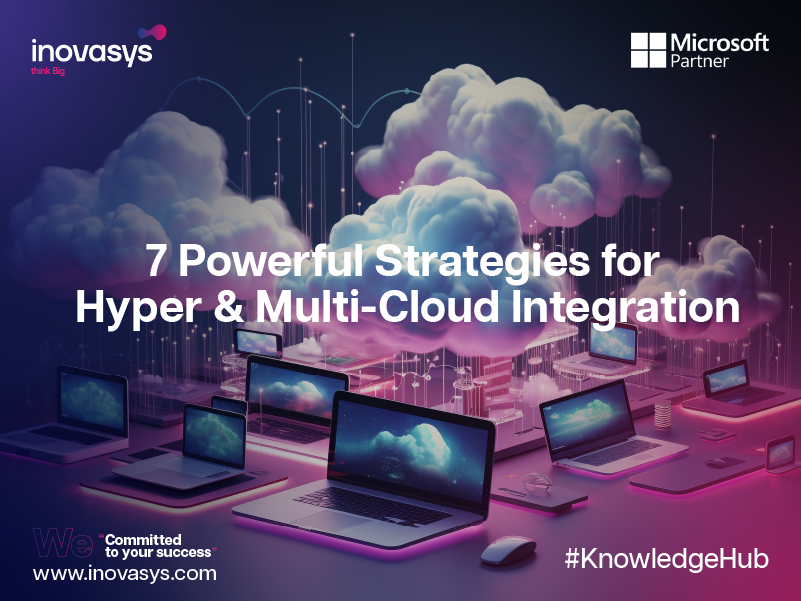Inovasys, founded in 2014, has been a leader in providing advanced technology solutions. By 2020, it became known as a service provider. The company aims to be the best partner for businesses looking to improve their operations with digital technology.
Articles & Press Release

7 Powerful Strategies for Hyper & Multi-Cloud Integration
1. Understanding Hyper & Multi-Cloud Integration
Hyper & Multi-Cloud Integration refers to a strategic combination of on-premises infrastructure and multiple cloud providers—such as Microsoft Azure, AWS, and Google Cloud—working together seamlessly.
-
Hybrid Cloud: Combines on-premises resources with public cloud platforms, ensuring control over sensitive workloads.
-
Multi-Cloud: Extends the strategy by leveraging services from several cloud providers to maximize flexibility and innovation.
This dual approach empowers enterprises to build bridges across the digital landscape, gaining the best of every environment while avoiding vendor lock-in.
2. Why Businesses Are Embracing Hyper & Multi-Cloud Integration
Enterprises are adopting Hyper & Multi-Cloud Integration to drive measurable business benefits:
-
Regulatory Compliance & Latency Control: Critical workloads stay on-premises while benefiting from cloud scalability.
-
Cost Optimization & Risk Reduction: Distributing workloads across providers prevents dependency on a single vendor.
-
Innovation at Scale: Access to unique tools, such as AI services from different providers, accelerates development.
-
Resilience Against Outages: Multi-cloud architectures safeguard business continuity even when one provider experiences downtime.
3. Microsoft Azure’s Role in Hyper & Multi-Cloud Integration
Microsoft Azure leads the charge with cutting-edge solutions designed for Hyper & Multi-Cloud Integration.
Azure Arc
Azure Arc extends Azure’s management, governance, and security controls across any environment—whether it’s another public cloud or an on-premises data center. With Arc, IT teams can:
-
Apply zero-trust security policies consistently.
-
Monitor and manage workloads across all clouds.
-
Deploy Azure SQL or Kubernetes clusters anywhere with ease.
This dramatically reduces the complexity and fragmentation traditionally associated with multi-cloud operations.
4. Powering Interoperability and Modern App Development
Modern applications depend on APIs, containers, and microservices. Azure’s commitment to open standards and cross-cloud tools allows developers to build once and run anywhere. This seamless interoperability makes Hyper & Multi-Cloud Integration the backbone of future-proof application development.
5. Overcoming Key Challenges
While the benefits are clear, Hyper & Multi-Cloud Integration comes with challenges:
-
Security & Identity Management: Unified identity controls and zero-trust frameworks are essential.
-
Consistent Monitoring: Centralized monitoring tools prevent blind spots across multiple platforms.
-
Governance & Compliance: Policies must remain consistent regardless of where data resides.
Microsoft’s integrated security solutions and Azure’s governance capabilities help enterprises overcome these obstacles effectively.
6. The Long-Term Business Case
Hyper & Multi-Cloud Integration is more than a trend—it’s the future of enterprise IT. Organizations that adopt this model:
-
Enhance operational flexibility to respond quickly to market changes.
-
Reduce vendor risk and ensure business continuity.
-
Unlock innovation by accessing the best services from each cloud provider.
Forward-thinking companies now ask not if they should embrace Hyper & Multi-Cloud Integration, but how to manage it effectively.
7. Building Your Hyper & Multi-Cloud Integration Roadmap
To succeed, organizations should:
-
Assess Workload Requirements – Identify which applications require on-premises control or specialized cloud services.
-
Choose the Right Providers – Match workloads to the provider that offers the best capabilities.
-
Implement Zero-Trust Security – Enforce strong identity and access management across all platforms.
-
Adopt Centralized Monitoring – Gain complete visibility across clouds and on-premises systems.
-
Leverage Automation Tools – Use orchestration and infrastructure-as-code to simplify operations.
Frequently Asked Questions (FAQs)
1. What is Hyper & Multi-Cloud Integration?
It is the strategic use of multiple cloud providers combined with on-premises infrastructure to achieve flexibility, scalability, and resilience while avoiding vendor lock-in.
2. What are the main benefits of Hyper & Multi-Cloud Integration?
Key benefits include cost optimization, improved resilience against outages, regulatory compliance, and access to the best features from each cloud provider.
3. What challenges should businesses prepare for?
Enterprises must address security, identity management, governance, and consistent monitoring across multiple platforms.
4. How does Microsoft Azure support Hyper & Multi-Cloud Integration?
Azure offers tools like Azure Arc for unified management and governance, enabling seamless operations across clouds and on-premises environments.
By embracing Hyper & Multi-Cloud Integration, enterprises can confidently build bridges across their digital landscape—unlocking innovation, reducing risk, and ensuring long-term agility. This is the ultimate path to a future-ready IT strategy.

